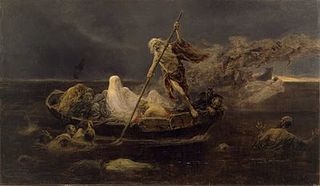| La Laguna Estigia | |
|---|---|
 | |
| Artist | Félix Resurrección Hidalgo |
| Year | 1887 |
La Laguna Estigia (The River Styx or The Styx), also known simply as Laguna Estigia,[1] is an 1887 Greco-Roman painting by Filipino painter Félix Resurrección Hidalgo. It is a companion-piece for Hidalgo's other painting entitled La barca de Aqueronte. Like the La barca de Aqueronte, the La Laguna Estigia is based on Dante's Inferno, the painter pursuing the theme leading towards a “darker” and “more somber interpretation” of it.[2]
The painting was a silver medalist during the 1887 Exposicion General de las Islas Filipinas in Madrid, Spain.[3]
References
[edit]- ^ Kulay-Diwa Gallery of Philippine Contemporary Art (2009). "Felix Ressurreccion Hidalgo". Archived from the original on 15 July 2010. Retrieved 28 March 2010.
- ^ "La Laguna Estigia (The River Styx) from La Barca de Aqueronte". Lopez Memorial Museum. 2003. Archived from the original on 14 January 2010. Retrieved 28 March 2010.
- ^ "La Laguna Estigia (The River Styx) from Module Three - El Asesinato Del Governador Bustamante Y Su Hijo: Powerand Conflict" (PDF). Lopez Memorial Museum. Archived from the original (PDF) on 16 July 2011. Retrieved 28 March 2010.
Well, that’s interesting to know that Psilotum nudum are known as whisk ferns. Psilotum nudum is the commoner species of the two. While the P. flaccidum is a rare species and is found in the tropical islands. Both the species are usually epiphytic in habit and grow upon tree ferns. These species may also be terrestrial and grow in humus or in the crevices of the rocks.
View the detailed Guide of Psilotum nudum: Detailed Study Of Psilotum Nudum (Whisk Fern), Classification, Anatomy, Reproduction